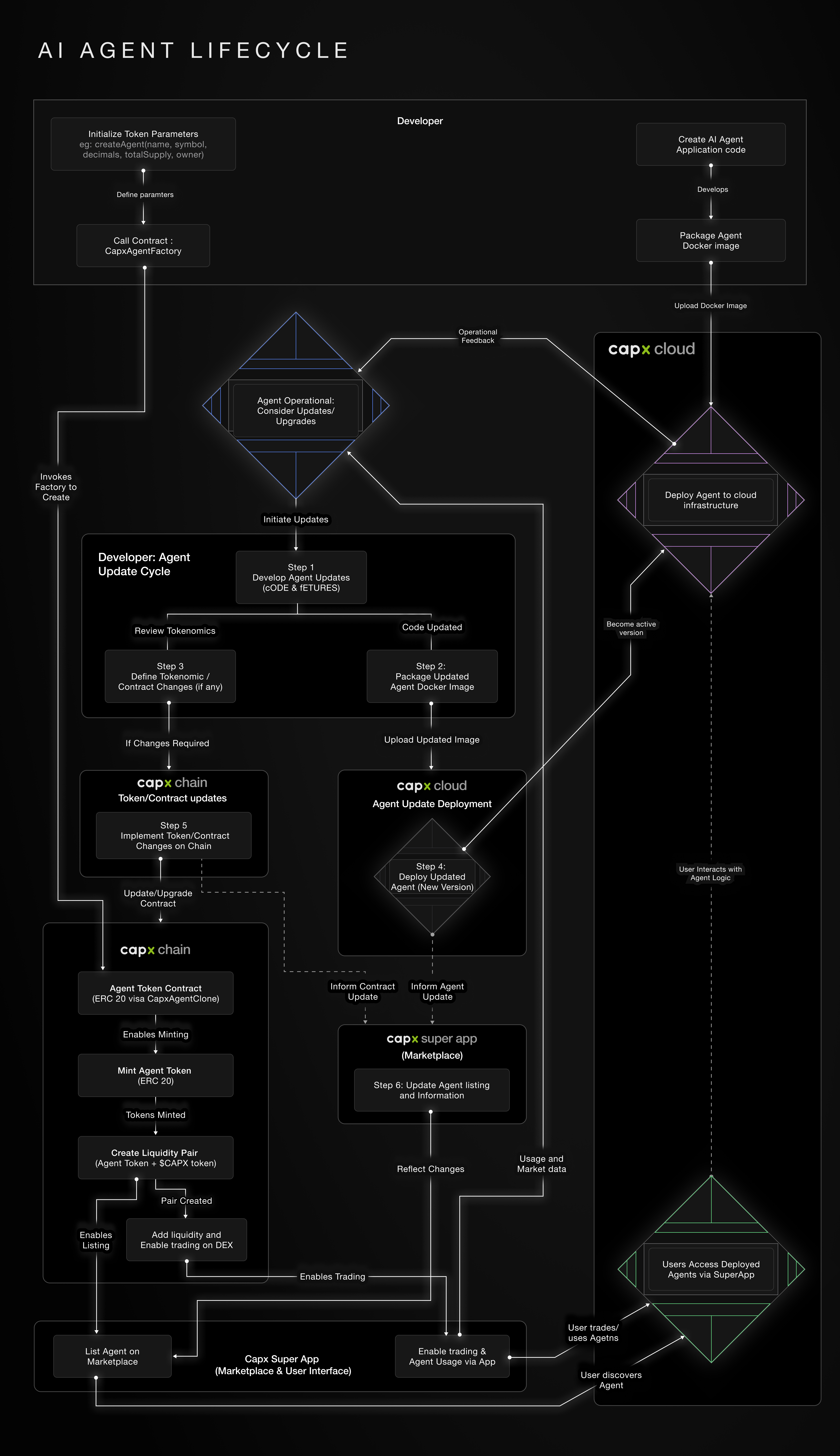
Phase 1: Conception, Development & Initial Token Setup (Developer-Centric)
- AI Agent Conceptualization & Coding: The journey begins with the Developer designing the AI agent. This includes defining its purpose, core functionalities, algorithms, and the specific AI/ML models it will utilize. The actual application code for the agent is then written.
- Containerization for Portability: The developed AI agent code and its dependencies are packaged, typically into a Docker image. This standardizes the agent’s environment, ensuring consistent operation and simplifying deployment across different infrastructures.
- Token Design & Parameter Initialization: Crucially, at this early stage, the Developer also designs the tokenomics for the AI agent. This involves defining the parameters for the agent’s unique digital token, such as its name, symbol, total supply, decimal places, and the initial owner. This step prepares for the token’s creation on the blockchain and outlines its intended utility (e.g., access, governance, staking).
- Smart Contract Interaction for Token Genesis: The Developer then interacts with a specific smart contract on the blockchain, often a “CapxAgentFactory.” This factory contract is designed to receive the token parameters and orchestrate the creation and deployment of a new, unique token contract specifically for this AI agent.
Phase 2: Cloud Deployment & On-Chain Token Materialization (Cloud & Blockchain Interaction)
- Agent Deployment to Cloud Infrastructure: The packaged Docker image containing the AI agent is uploaded and deployed to the cloud infrastructure. This cloud environment provides the necessary computational resources (CPU, GPU, memory, etc.) for the AI agent to run, execute its tasks, and be accessible.
- Agent-Specific Token Contract Creation: Simultaneously, as a result of the interaction with the Agent Factory in the previous phase, a new smart contract is deployed on the blockchain. This contract, often adhering to standards like ERC20, becomes the definitive on-chain representation and ledger for the AI agent’s specific tokens.
- Token Minting: With the agent’s unique token contract now live on the blockchain, the specified supply of tokens is “minted” (created) according to the parameters defined by the Developer. These tokens are typically credited to the owner address specified during initialization.
Phase 3: Enabling Market Access, Liquidity & Token Utility (Blockchain & User Platform Integration)
- Liquidity Pair Creation & Provisioning: To enable the agent’s tokens to be traded and to establish a market value, they are typically paired with a base currency (e.g., $CAPX) on a Decentralized Exchange (DEX) operating on the blockchain. The Developer or initial backers then “add liquidity” by depositing a quantity of both the agent tokens and the base currency into this liquidity pool.
- Marketplace Listing: Once the AI agent is deployed in the cloud and its tokens have liquidity, it is listed on a user-facing platform or marketplace (e.g., Capx Super App). This listing provides potential users with information about the agent’s capabilities, its token details, and how to acquire or utilize its services.
- Enabling Trading & Agent Usage via Platform: The user-facing platform facilitates the trading of the agent’s tokens (leveraging the DEX liquidity) and provides the interface for users to interact with or consume the AI agent’s services, often using the acquired tokens.
Phase 4: User Interaction & Token-Driven Engagement (User Platform & Cloud Interaction)
- User Discovery & Token Acquisition: Users discover the agent through the marketplace. Depending on the agent’s model, they might need to acquire its specific tokens to access its services, participate in its governance, or unlock premium features.
- Service Invocation & Token Utility: Users interact with the AI agent by sending requests or tasks via the user-facing platform. This interaction might involve “spending” agent tokens, holding a certain amount as an access key, or staking them. The platform routes these requests to the deployed AI agent running on the cloud infrastructure.
- Task Execution & Response: The AI agent processes the input, performs its computations, and returns the results or actions back to the user through the platform. The token acts as a key mechanism for value exchange and access control.
Phase 5: Monitoring, Maintenance, Evolution & Tokenomic Adjustments (Iterative Cycle)
- Performance Monitoring & Feedback Collection: The operational agent is continuously monitored for performance, resource usage, and accuracy. User feedback and interaction data are collected to identify areas for improvement.
- Identifying Need for Updates (Agent & Tokenomics): Based on monitoring, feedback, or evolving market demands, a need for updates may arise. This can apply to the AI agent’s core logic, features, or even its tokenomics (e.g., introducing new utility for the token, adjusting supply mechanisms).
- Iterative Re-Development:
- Agent Code Updates: Developers modify the agent’s application code to implement improvements, new features, or bug fixes.
- Tokenomic/Contract Adjustments (If any): If changes to the token’s utility or the underlying smart contract logic are required, these are designed and developed.
- Re-Packaging & Re-Deployment:
- A new version of the AI agent is packaged (e.g., new Docker image).
- The updated agent is deployed to the cloud infrastructure, often replacing or versioning the older instance.
- Chain Updates (If Necessary): Significant changes to token contracts might require deploying new contracts or migrating data/state on the blockchain, a process that needs careful management and often community involvement if governance is decentralized.
- Marketplace & Platform Updates: The agent’s listing on the user-facing platform is updated to reflect the new features, version, and any changes in its token utility or access mechanisms.
